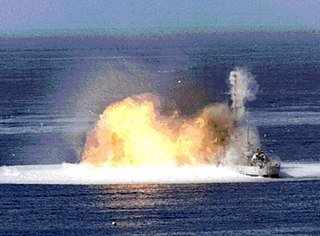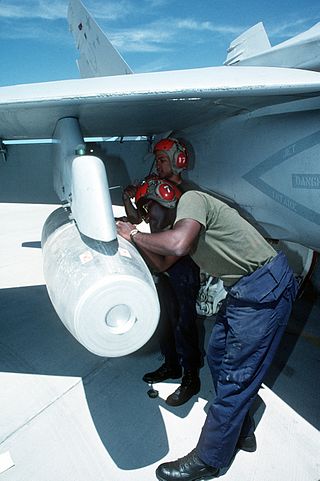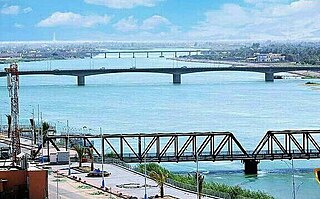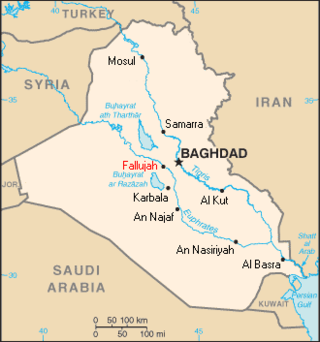Related Research Articles

A Molotov cocktail is a hand-thrown incendiary weapon consisting of a frangible container filled with flammable substances and equipped with a fuse. In use, the fuse attached to the container is lit and the weapon is thrown, shattering on impact. This ignites the flammable substances contained in the bottle and spreads flames as the fuel burns.

Napalm is an incendiary mixture of a gelling agent and a volatile petrochemical. The name is a portmanteau of two of the constituents of the original thickening and gelling agents: coprecipitated aluminium salts of naphthenic acid and palmitic acid. A team led by chemist Louis Fieser originally developed napalm for the US Chemical Warfare Service in 1942 in a secret laboratory at Harvard University. Of immediate first interest was its viability as an incendiary device to be used in fire bombing campaigns during World War II; its potential to be coherently projected into a solid stream that would carry for distance resulted in widespread adoption in infantry flamethrowers as well.

A thermobaric weapon, also called an aerosol bomb, or a vacuum bomb, is a type of explosive munitions that work by dispersing an aerosol cloud of gas, liquid or powdered explosive. Thermobaric weapons are almost 100% fuel and as a result are significantly more energetic than conventional explosives of equal weight. The fuel is often elemental. Many types of thermobaric weapons can be fitted to hand-held launchers, and can also be launched from airplanes.

Incendiary weapons, incendiary devices, incendiary munitions, or incendiary bombs are weapons designed to start fires or destroy sensitive equipment using fire, using materials such as napalm, thermite, magnesium powder, chlorine trifluoride, or white phosphorus. Though colloquially often known as bombs, they are not explosives but in fact are designed to slow the process of chemical reactions and use ignition rather than detonation to start or maintain the reaction. Napalm, for example, is petroleum especially thickened with certain chemicals into a 'gel' to slow, but not stop, combustion, releasing energy over a longer time than an explosive device. In the case of napalm, the gel adheres to surfaces and resists suppression.

Fallujah is a city in Al Anbar Governorate, Iraq. Situated on the Euphrates River, it is located roughly 69 kilometres (43 mi) to the west of the capital city of Baghdad. The city dates back to the Babylonian era and was host to important Jewish academies for many centuries.

The First Battle of Fallujah, code-named Operation Vigilant Resolve, was an operation against militants in Fallujah as well as an attempt to apprehend or kill the perpetrators of the killing of four U.S. contractors in March 2004.

After the invasion of Iraq was completed and the regime of Saddam Hussein was toppled in May 2003, the Iraqi insurgency began. The 2003–2006 phase of the Iraqi insurgency lasted until early 2006, when it escalated from an insurgency to a civil war, which became the most violent phase of the Iraq War.

A smoke screen is smoke released to mask the movement or location of military units such as infantry, tanks, aircraft, or ships.

The Second Battle of Fallujah, initially codenamed Operation Phantom Fury,Operation al-Fajr was an American-led offensive of the Iraq War that lasted roughly six weeks, starting 7 November 2004. Marking the highest point of the conflict against the Iraqi insurgency, it was a joint military effort carried out by the United States, the Iraqi Interim Government, and the United Kingdom. Within the city of Fallujah, the coalition was led by the U.S. Marine Corps and U.S. Army, the battle was later described as "some of the heaviest urban combat U.S. military have been involved in since the Battle of Huế City in Vietnam in 1968".

The Mark 77 bomb (MK-77) is a United States 750-pound (340 kg) air-dropped incendiary bomb carrying 110 U.S. gallons of a fuel gel mix which is the direct successor to napalm.

The RPO-A Shmel' is a man-portable, single-use, rocket-assisted thermobaric weapon. Despite the literal translation referring to the weapon as a flamethrower, it does not produce a jet of burning liquid - it is in fact an unguided rocket launcher that fires rounds that explode into a cloud of very hot gases.

White phosphorus munitions are weapons that use one of the common allotropes of the chemical element phosphorus. White phosphorus is used in smoke, illumination, and incendiary munitions, and is commonly the burning element of tracer ammunition. Other common names for white phosphorus munitions include WP and the slang terms Willie Pete and Willie Peter, which are derived from William Peter, the World War II phonetic alphabet rendering of the letters WP. White phosphorus is pyrophoric ; burns fiercely; and can ignite cloth, fuel, ammunition, and other combustibles.

The United States bombardment of Fallujah began in April 2003, one month after the beginning of the invasion of Iraq. In April 2003 United States forces fired on a group of demonstrators who were protesting against the US presence. US forces alleged they were fired at first, but Human Rights Watch, who visited the site of the protests, concluded that physical evidence did not corroborate US allegations and confirmed the residents' accusations that the US forces fired indiscriminately at the crowd with no provocation. 17 people were killed and 70 were wounded. In a later incident, US soldiers fired on protesters again; Fallujah's mayor, Taha Bedaiwi al-Alwani, said that two people were killed and 14 wounded. Iraqi insurgents were able to claim the city a year later, before they were ousted by a siege and two assaults by US forces. These events caused widespread destruction and a humanitarian crisis in the city and surrounding areas. As of 2004, the city was largely ruined, with 60% of buildings damaged or destroyed, and the population at 30%–50% of pre-war levels.
Chlorine bombings in Iraq began as early as October 2004, when insurgents in Al Anbar province started using chlorine gas in conjunction with conventional vehicle-borne explosive devices.
Al-Karmah, also sometimes transliterated as Karma, Karmah, or Garma, is a city in central Iraq, 16 km (10 mi) northeast of Fallujah in the province of Al Anbar.

Incendiary ammunition is a type of ammunition that contains a chemical that, upon hitting a hard obstacle, has the characteristic of causing fire/setting flammable materials in the vicinity of the impact on fire.

The Anbar campaign consisted of fighting between the United States military, together with Iraqi security forces, and Sunni insurgents in the western Iraqi governorate of Al Anbar. The Iraq War lasted from 2003 to 2011, but the majority of the fighting and counterinsurgency campaign in Anbar took place between April 2004 and September 2007. Although the fighting initially featured heavy urban warfare primarily between insurgents and U.S. Marines, insurgents in later years focused on ambushing the American and Iraqi security forces with improvised explosive devices (IEDs), large scale attacks on combat outposts, and car bombings. Almost 9,000 Iraqis and 1,335 Americans were killed in the campaign, many in the Euphrates River Valley and the Sunni Triangle around the cities of Fallujah and Ramadi.

A barrel bomb is an improvised unguided bomb, sometimes described as a flying IED. They are typically made from a large barrel-shaped metal container that has been filled with high explosives, possibly shrapnel, oil or chemicals as well, and then dropped from a helicopter or aeroplane. Due to the large amount of explosives, their poor accuracy, and indiscriminate use in populated civilian areas, the resulting detonations have been devastating. Critics have characterised them as weapons of terror and illegal under international conventions.
The Protocol on Prohibitions or Restrictions on the use of Incendiary Weapons is a United Nations treaty that restricts the use of incendiary weapons. It is Protocol III to the 1980 Convention on Certain Conventional Weapons Which May Be Deemed To Be Excessively Injurious Or To Have Indiscriminate Effects. Concluded in 1981, it entered into force on 2 December 1983. As of January 2023, it had been ratified by 126 state parties.
The most significant using of incendiary weapons were used a number of times during the Russo-Ukrainian War. Russians were accused of using white phosphorus bombs multiple times; in the Battle of Kyiv and against Kramatorsk in March 2022, against dug-in defenders at the Azovstal steel plant in Mariupol in May 2022, and in Marinka over the 2022 Christmas holiday. White phosphorus is a toxic chemical, and exposure to vapors leads to long-term ailments of the body, up to permanent disfigurement and death through organ failure.
References
- ↑ "White Phosphorus: Systemic Agent". cdc.gov. Centers for Disease Control and Prevention. Retrieved 2 December 2022.
- 1 2 White Phosphorus Fact Sheet, Federation of American Scientists
- ↑ "UNODA Treaties". treaties.unoda.org. Retrieved 20 July 2023.
- ↑ Buncombe, Andrew; Solomon Hughes (15 November 2005). "The fog of war: white phosphorus, Fallujah and some burning questions". The Independent. Archived from the original on 3 May 2008. Retrieved 7 June 2013.
- ↑ Ingram, Adam. "D/MSU/4/5/2". UK Ministry of Defense. Retrieved 7 June 2013.
- ↑ Buncombe, Andrew; Hughes, Solomon (15 November 2005). "The fog of war: white phosphorus, Fallujah and some burning questions". The Independent. Retrieved 23 January 2020.
- 1 2 Monbiot, George (22 November 2005). "Behind the phosphorus clouds are war crimes within war crimes". guardian.co.uk. The Guardian. Retrieved 2 December 2022.
- ↑ Staff. Heated debate over white phosphorus BBC NewsWatch 17 November 2005.
- ↑ Cancer, Infant Mortality and Birth Sex-Ratio in Fallujah, Iraq 2005–2009, Chris Busby, Malak Hamdan, Entesar Ariabi, Int. J. Environ. Res. Public Health 2010, 7(7), 2828-2837; https://doi.org/10.3390/ijerph7072828
- ↑ Kelley, Michael B (18 April 2012). "The US Poured So Many Toxic Weapons On Fallujah In 2004 That Residents Still Pay The Price". businessinsider.com. Business Insider. Retrieved 3 December 2022.